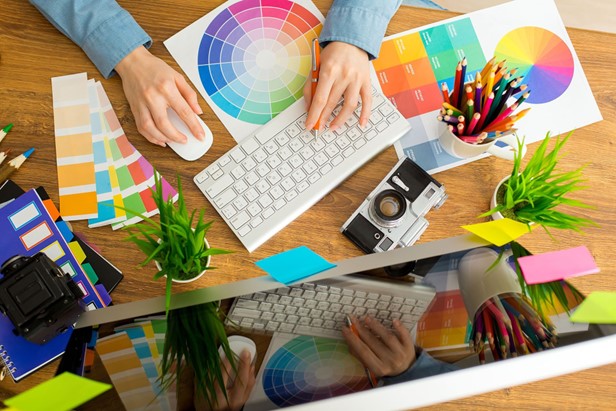The value of design thinking: Incorporating creative and graphic design into pharma market research
How do we keep research design fresh and interesting? How do we ensure that we’re inspiring our respondents to give us enlightening new insights, and encourage new ways of thinking? There is a strong precedent for incorporating ‘‘design thinking’’ into methods for improving aspects of healthcare delivery, particularly now that there is a greater emphasis on patient centricity and improving the customer experience.
A great story of design in product development comes from Doug Dietz, a principal designer for GE Healthcare. After spending two years designing a new MRI scanner, he was excited to see it in action. But at the hospital, as he observed a young family with a child approaching, he realized that the child was terrified.
“Looking [from] her angle and seeing that same environment … I realised something. On the wall is that horrible warning sticker … that yellow and black tape almost like an accident scene … everything looks really beige, everything’s bleached out. The room itself is kind of dark; it’s got these flickering fluorescent lights, and the machine itself – that I designed – basically looks like a brick with a hole in it. And of course an MRI … it makes just a terrible noise. So the little girl just starts to cry.” (Dietz, 2012)
Investigating the issue further, Dietz discovered that pediatric patients were so frightened of the scanners that 80% of young patients had to be sedated before being scanned, creating even more stress for patients and parents at an already worrying time. The experience was a huge wake-up call for Dietz, who felt he’d failed in his job as a product designer. To solve this problem, he gathered a team of design experts, hospital employees, and staff from a local children’s museum, and engaged in his own form of market research by having children draw and color in their own idea of an adventure. Drawing from the fertile imaginations of children, the team’s work resulted in the GE Adventure series, installed as a pilot scheme in the University of Pittsburgh. These MRI scanners were designed with soft round edges instead of hard corners and themed around jungles, pirate islands, and underwater castles, with the rooms utilizing multi-sensory immersive techniques such as lighting, music and aroma to put young patients at ease.
“For a modality such as this, where kids are being sedated around 80% of the time – I think these machines have been installed for … maybe a year now, and they’ve sedated two kids. Like, 0.-something [percent]. … Patient satisfaction went up by 92%.” (Dietz, 2012)
As somebody with a real passion for design, I wonder – if design is increasingly valued as a means of improving the daily healthcare experience, can it be used to increase the value of healthcare market research as well?
In The Studio, Research Partnership’s creative services division, we have been looking at ways in which we can elevate the research process and the insights we uncover by bringing design and creativity into all stages of the project lifecycle. We have been successfully offering a wide variety of creative outputs as supports or leave-behind deliverables for our clients, following completion of their projects. Now, we’re also aiming to enhance research further by inputting design thinking into the research methodology.
For example, we know that surveys are better when they are visually appealing and engaging to respondents. Like the little girl facing an intimidating MRI scanner, we all know that being faced with a long, complex, and wordy questionnaire can be intimidating for some respondents as well, while others might find the same task dry, unpleasant, or dull. From the perspective of both HCPs and patients, all of whom live in an increasingly noisy world of attention-grabbing advertisements, event television and ever-present social media, research techniques that closely mimic something that they may interact with on a regular basis – such as a magazine, game, touchscreen interface, or video – or that aid as props to better help ground them into a particular scenario, will serve to maximize respondent engagement and prompt a response that is either more natural or from a new perspective. These in turn provide even richer insights. My colleague Tom used immersive stimulus materials created by the Studio team to build a ‘‘future world’’ environment. The detailed designs of newspapers, medical journals, and props set years into the future really helped respondents get into the mindset of how they might think, feel, and behave in a world that is yet to exist.
We can also create props for client teams to help with immersion workshops or to facilitate discussion at Central Location days. We created ‘‘Backroom Brainstorm’’; interactive backroom exercises to engage viewers, generate discussion, and encourage collaboration between all attendees on what key insights can initially be picked up from the pilot interviews. The Studio design team has designed dry-wipe graphics, prompt postcards, and other attractive dialogue stimulus to help propel discussion along.
These are just two examples of areas in which creative design can enhance research, but we are able to offer so much more. The Studio specializes in the production of high-quality visual multi-media, including illustration, graphic design, infographics, interactive outputs, 3D, film, and animation. In The Studio, there are no impossibilities – there are only solutions.
By using the boundary-pushing creative approach of a specialist design agency, The Studio hopes to offer our clients the best quality design throughout the entire research process, from fieldwork to final delivery and beyond.

Sign up to receive Rapport.
Rapport is our monthly newsletter where we share our latest expertise and experience.